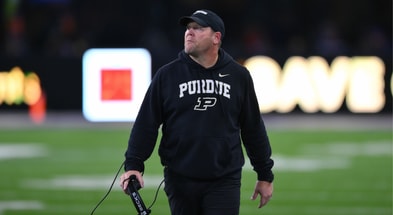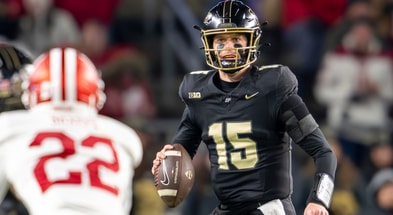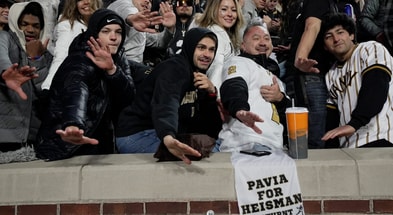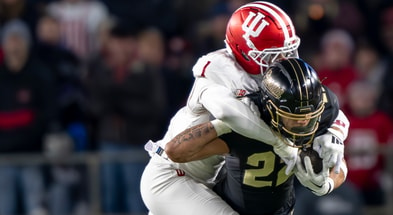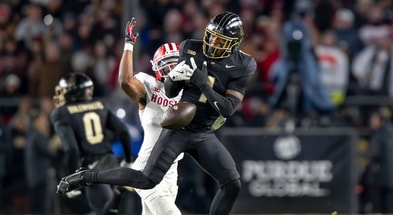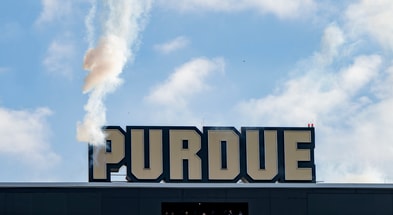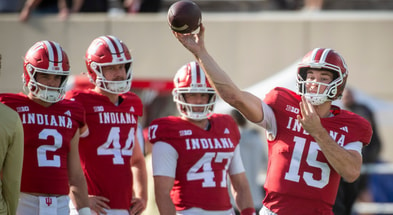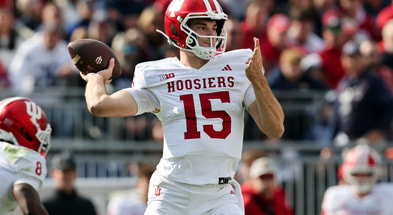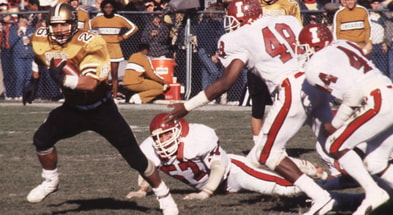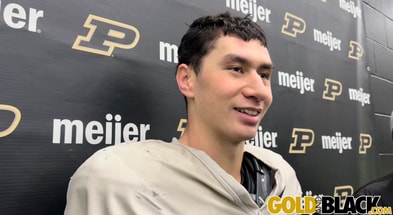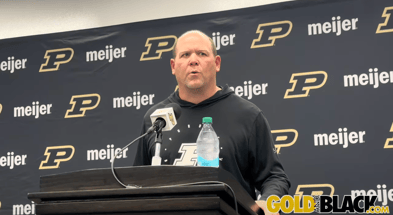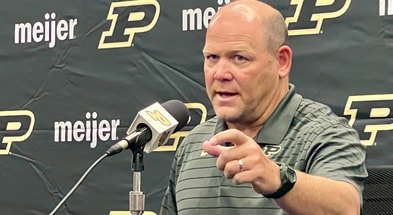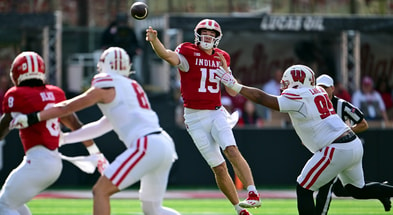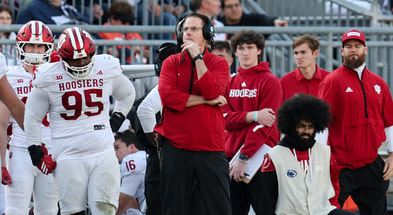Purdue AD Mike Bobinski on: Ryan Walters, scheduling, B1G expansion, House settlement and more
Purdue athletic director Mike Bobinski talked to GoldandBlack.com’s Alan Karpick last Friday about a variety of important topics on Gold and Black LIVE. Here the major subjects that Bobinski discussed. The full video interview is embed below.
ON RYAN WALTERS:
I think he’s learned, and you can only learn it by doing it. I know when I got my first athletic director job, I thought I was 100% prepared and could do it better than anyone could ever imagine. And I learned very quickly that I didn’t know what I didn’t know at that point.
So, I think Ryan (Walters) has really learned where to best apply his time to have the greatest impact, to really function as a head coach in the most effective way possible. He learned, I think, early last year–a couple games in–not being in the heat of the action, calling the defensive side of the ball, was something that really kept him engaged at a high level. I think now we’re not changing gears this year, we’re coming out of the box with a very sound and stable approach, sort of in all those different areas. And I like that.
I think Ryan’s really, really grown into it. He’s a very, very intelligent guy, as I think is obvious to everybody. He’s very thoughtful and analytical, has rebuilt the roster with a strategy. It wasn’t just sort of grab bag: Hey, let’s just grab whoever we can get. It was: Let’s go for positions of real need where we were not as good as we needed to be. And I think they’ve really shored up some places where we were not at a high level last year. So, that part has been really exciting, and I think that will just continue to get better and better as he fine-tunes things over the years here.
ON LEADERSHIP ON THE FIELD:
I would say on the offensive side, with Hudson (Card) and Gus Hartwig, you’ve got two really, really strong folks.
Gus has been a mainstay since the day he got here, other than that chunk when he got hurt. He is a big-time player. He’s not very vocal, that’s not his thing. But he’s strong. He expects everybody around him to play to a certain standard. And I think everyone responds to that very, very positively.
MORE: Purdue eases into bye week with visit from Notre Dame looming | GoldandBlack.com Radio: Schultz and Dienhart talk bye week/Notre Dame | Purdue roster
Hudson, I think, has really blossomed in a leadership role. A year ago, it is not his natural thing to sort of be in charge, to be that guy. I mean, again, he’s a very capable, very smart young man. Understands the game really well, but this year really has a command of the huddle and of the offense and of the relationships that he needs to have with his line, with his receivers. And as I’ve watched him, his decision-making, everything has, to me, progressed to a much higher level. And, as a result, I think the players really respond and respect his ability and know that when he’s on that field, we’re gonna have a chance to have really good things happen.
ON LOW EXPECTATIONS FOR TEAM BY EXPERTS:
There’s very rarely an original thought given. Once somebody issues a prognostication, everybody sort of falls in line with the same sort of lazy approach, in my opinion, having watched this a long time. None of those folks had actually been here and seen or really dug deep into the flip and the changes to our roster and our personnel.
They looked at, well, Nic Scouton left, and the four top receivers. Nic is obviously a great player. And our receivers, they worked hard, but were they All-American-caliber? No, let’s be honest, they weren’t. And so, you know, it wasn’t the loss that maybe on paper it appeared to be.
So, I would tell you that I think that was a lot overblown, and a lot of not very deep in-depth work was done analyzing where we are going forward. That has, I think, certainly hit home with our locker room and the whole building over there. Not that we need anything more to get us ready to compete, but it’s always nice to say, hey, you know what? We didn’t receive a lot of respect. People don’t really believe much in who we are, and now we have a chance 12 times during the regular season to go out and prove who we are.
We’re not going to talk about it. We’d rather just go do it. And I think that’s the approach. And I like that. There’s a very sort of resolve about this group that I really like where they, you know, they believe in each other, they believe in what they’re capable of. And I know they’re anxious to get out there and show it.
ON SCHEDULING:
As we think about it going forward, we want to be as balanced as we can be. Last year was a heavy lift early on. This year, Indiana State is a nice lead-in to the year. In Big Ten rules, you’re only allowed to play one FCS. That’s the scheduling guideline, unless there are some incredibly extenuating circumstances where you’re up against it and couldn’t find anybody but another one. But, typically, one FCS per year.
We’d like to balance that out and have, over time, work it to where we maybe have a Group of Five and FCS and then a Power Four team as sort of our lead-in to our year. It’ll take some time. We’re not going to bail out on a bunch of contracts, unless there’s a mutual interest to walk away from future games or series. And that, I think, is something that you never know.
As the world shifts, as conference alignment is different today than it was, and who knows if nine conference games is the end-all-be-all for the Big Ten. Who knows? As we get closer and closer in alignment with the SEC from a partnership perspective, maybe we end up with a scheduling arrangement where Big Ten and SEC play each other every year in a game. So, there’s lots of things that could happen that might affect our future schedules.
But in terms of what we would like to do is really strike a balance. I don’t think any coach, I know our coach, Coach Walters, as with Jeff Brohm, nobody thinks three layups is a great idea. When you’re getting ready to play in the Big Ten, you’ve got to be tested. You got to know what it looks like to play against real people. That being said, you want to come out of it in a reasonably confident and healthy way to the best of your ability. And so having some more balance, I think, is the plan going forward.
ON FUTURE CONFERENCE EXPANSION:
I think, just out of necessity, and with all the other elements that are in play right now, that it’ll be quiet for a period of time.
From the Big Ten perspective, the only way it would ever make sense for us to be something other than 18 teams would be if someone can come in that adds clear and unquestioned value to the table. Having just more teams in and around our conference makes no sense unless they actually are value adds because every new player at the table is another mouth that has to be fed. And if you’re splitting the same pie by just more slices, that’s doesn’t make any sense to anybody.
Top 10
- 1Breaking
Mark Stoops
Kentucky to fire head coach
- 2
Pat Fitzgerald
Returns as Big Ten head coach
- 3Hot
Lane Kiffin
Statement on LSU, Ole Miss
- 4Trending
Pete Golding
Hired as Ole Miss head coach
- 5
Jon Sumrall
UF expected to hire Tulane HC
Get the Daily On3 Newsletter in your inbox every morning
By clicking "Subscribe to Newsletter", I agree to On3's Privacy Notice, Terms, and use of my personal information described therein.
So, it would have to be somebody that brings, you know, plus value, and there are very few of those that exist in the landscape right now, period. I mean, there just aren’t. So, I think there’s not a lot of obvious things that would happen from a Big Ten perspective going forward.
ON THE HOUSE SETTLEMENT:
My understanding is that the settlement terms have been put in front of the judge, Judge Wilken, out in the Ninth Circuit in California. I believe September 5, which is next Thursday, is the date that has been set where we anticipate that she will issue her preliminary ruling on the terms of the settlement.
We’d like to think that she will approve the terms as presented, the plaintiff’s attorneys and the Power Five conferences because all five were defendants along with the NCAA. We’ve all agreed on the basic terms, and we’d like to think that will be compelling to the judge, that everybody came to that resolution sort of willingly and knowingly. Once that happens, there is an official period for challenge or objections to be filed with the court on the terms. …
There are people posturing that this isn’t right. It could be done this way or that way. I mean, of course, it’s a free country, and people are free to express their opinions. Some of those objections, I think, are, in my opinion, short-sighted and don’t really take in the entire picture. But that’s for the judge ultimately to decide if, in fact, those challenges are deemed to be not worthy. Hopefully, about six months after her preliminary ruling, the settlement will be fully certified and then be able to be implemented for the 25-26 year.
So, this current year, we’re operating business as usual, or business as it has been for these last couple of years, which is really anything but usual. It’s the same as it has been these last couple of years. But, in 25-26, we’ll enter into a new economic model, a new scholarship/roster model.
So, there’ll be lots of change that we are preparing for in anticipation that the settlement will basically stay together in large part as it’s written right now. So, we’re working hard, as all of our colleagues around the Big Ten are, to make sure that we’re prepared for what happens in 25-26.
ON THE NEED FOR DONOR SUPPORT:
Donor support will be not less important, but maybe even more important going forward. And I’d like to think that we can provide a little more clarity.
I think as an industry, we have offered a pretty confusing environment these last couple years with: Do I support this initiative, which is sort of external to the university? Or do I support internal causes? I’d like to think that once we get the settlement fully in place, we’ll be able to be a lot more direct and upfront with our donors as to where they might direct their support. But it is going to be really important.
We’re going to certainly have things we’re going to want to continue to do in and around our facilities. Ross-Ade is a prime example. It’s a stadium that we all love, I love it, I love where it is. But there are improvements that will need to be made and updates that will need to be made. It’s 100 years old in some places and 50 years old in other places, but it’s going to need to continue to move forward in order for us to be competitive in this new world, so that will continue to happen.
And then just pure operating support as we enter what appears to be a new situation where a significant chunk of our operating revenue will be siphoned off the top. We’re going to be challenged to continue to operate this program at a really high level. And I think we have an opportunity, if we can continue to generate the support that we’ve been so fortunate to have from our donors over the last couple years, if we can continue down that path and sort of that upward trajectory, I think the new environment really plays well for Purdue. I think we’re really incredibly well-positioned. But some of it does rely on our donors continuing to be with us, and I have every confidence that they will.
ON WORKING WITH THE UNIVERSITY TO SUPPORT ATHLETICS
It will require some rethinking of how our relationship is with the university, but it will still be incumbent upon us to continue to drive revenue, control expenses, do all the things that we’ve tried to do at a high level in recent years. And I think we’ve been reasonably successful, and that is what, honestly, I believe, has allowed us to be positioned to be successful, because we’ve been really pretty smart, and go way back before me, and efficient in how we manage resources and and push revenues.
It gave the university confidence, I believe, to partner with us going forward, knowing that we’re going to continue to do our part in being as responsible as we can and we will step forward and help in ways that allow us to compete at the full revenue share cap, and in a way that allows us to be right there with everybody in the Big Ten and beyond.
MORE: Purdue football staffers set to hit road to recruit during off week. Where are they headed? | Monster? Terminator? Looming star? 6-6 rush end Will Heldt carries weight of big expectations | The 3-2-1
